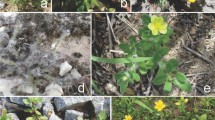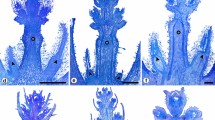Abstract
Structure of inflorescence and its variation were organographically and ontogenetically studied inLespedeza cuneata (Dum.-Cours.) G. Don. An axillary inflorescence of the species forms a compound inflorescence which is composed of three or four component inflorescences. Each component inflorescence bears four (rarely six), three, two, or one flowers. Based on the arrangement of inflorescence phyllomes, the component inflorescence with four flowers is interpreted as a pseudoraceme bearing two shortened lateral shoots (partial inflorescences) each of which has two flowers. The component inflorescence with one flower appears to be terminated by the flower and to compose the cyme. Organographic observations revealed that the terminally located flower is not truly terminal, but axillary in origin. Ontogenetic observations showed that the apices of component inflorescence and partial inflorescence exist in early developmental stages in spite of variation in the form of component inflorescence. The terminally located flower in the cyme-like inflorescence was thus demonstrated to be laterally borne on the partial inflorescence axis. The component inflorescence composing the cyme-like one inL. cuneata is a reduced form in the number of partial inflorescences and of flowers from the pseudoraceme. The cyme-like inflorescence inL. cuneata resembles the inflorescence ofKummerowia.
Similar content being viewed by others
References
Akiyama, S. 1988. A revision of the genusLespedeza sectionMacrolespedeza (Leguminosae). Univ. Mus. Univ. Tokyo Bull. No. 33: 1–178.
— andH. Ohba. 1985. The branching of the inflorescence and vegetative shoot and taxonomy of the genusKummerowia (Leguminosae). Bot. Mag. Tokyo98: 137–150.
Arber, A. 1925. Monocotyledons. Cambridge Univ. Press, Cambridge.
Bentham, G. 1865. Leguminosae.In G. Bentham and J.D. Hooker, Genera Plantarum1: 434–600. Lovell Reeve & Co., London.
Clewell, A.F. 1966. Native North American species ofLespedeza (Leguminosae). Rhodora68: 359–405.
Eames, A.J. 1961. Morphology of the Angiosperms. McGraw-Hill, New York.
Fu, S. 1955.Lespedeza.In Flora Illustralis Plantarum Primarum Sinicarum, pp. 517–532. Science Press, Beijing.
Goebel, K. 1931. Blütenbildung und Sprossgestaltung. Fischer, Jena.
—. 1933. Organographie der Pflanzen3. Fischer, Jena.
Hutchinson, J. 1964. Lespedezae.In The Genera of Flowering Plants1: 486–489. Oxford Univ. Press, London.
Jackson, B.D. 1928. A Glossary of Botanic Terms, 4 ed. Gerald Duckworth, London.
Lackey, J.A. 1981. Phaseoleae.In R.M. Polhill and P.H. Raven, ed., Advances in Legume Systematics1: 301–327. Royal Botanic Gardens, Kew.
Liu, Y. 1955.Kummerowia.In Flora Illustralis Plantarum Primarum Sinicarum, pp. 544–546. Science Press, Beijing.
Maximowicz, C.J. 1873. Synopsis generisLespedezae, Michaux. Act. Hort. Petrop.2: 328–388.
Nakai, T. 1927.Lespedeza of Japan and Korea. Bull. For. Exp. Stat. Chosen6: 1–101.
Nemoto, T. andH. Ohashi. 1988. Floral nectaries inLespedeza, Kummerowia andCampylotropis (Leguminosae). Journ. Jap. Bot.63: 112–126.
Ohashi, H. 1973. The Asiatic species ofDesmodium and its allied genera (Leguminosae). Ginkgoana1. Tokyo.
—. 1982.Lespedeza.In Y. Satakeet al., ed., Wild Flowers in Japan, Herbaceous Plants (Including Dwarf Subshrubs)2: 204–206. Heibonsha Ltd., Tokyo (in Japanese).
—,R.M. Polhill andB.G. Shubert. 1981. Desmodieae.In R.M. Polhill and P.H. Raven, ed., Advances in Legume Systematics1: 292–300. Royal Botanic Gardens, Kew.
Ohwi, J. 1965a. Flora of Japan. Smithsonian Inst., Washington, D.C. (in English).
—. 1965b. Flora of Japan, rev. ed., Shibundo Co., Tokyo (in Japanese).
Rickett, H.W. 1954. Materials for a dictionary of botanical terms II. Bull. Torrey Bot. Club81: 188–198.
Schindler, A.K. 1913. Einige Bemerkungen überLespedeza Michx. und ihre nächsten Verwandten. Engler, Bot. Jahrb.49: 570–658.
Taubert, P. 1894. Leguminosae.In A. Engler and K. Prantl, Die natürlichen Pflanzenfamilien III,3: 70–396 (Lespedeza 332). Wilhelm Engelmann, Leipzig.
Troll, W. 1948. Allgemeine Botanik. Ferdinand Enke Verlag, Stuttgart.
— 1954. Praktische Einführung in die Pflanzenmorphologie1. Fischer, Jena.
— 1957. Praktische Einführung in die Pflanzenmorphologie2. Fischer, Jena.
— 1964. Die Infloreszenzen, Typologie und Stellung in Aufbau des Vegetationskörpers1. Fischer, Jena.
— 1969. Die Infloreszenzen, Typologie und Stellung in Aufbau des Vegetationskörpers2. Fischer, Jena.
Tucker, S.C. 1987. Pseudoracemes in papilionoid legumes: their nature, development, and variation. Amer. J. Bot.95: 181–206.
Author information
Authors and Affiliations
Rights and permissions
About this article
Cite this article
Nemoto, T., Ohashi, H. Organographic and ontogenetic studies on the inflorescence ofLespedeza cuneata (Dum.-Cours.) G. Don (Leguminosae). Bot Mag Tokyo 103, 217–231 (1990). https://doi.org/10.1007/BF02489627
Received:
Accepted:
Issue Date:
DOI: https://doi.org/10.1007/BF02489627




